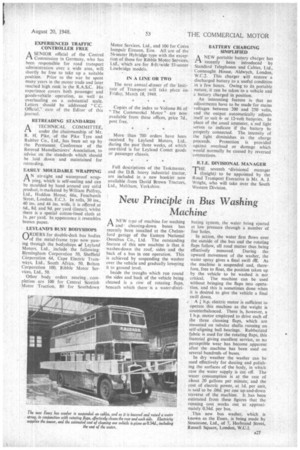New Principle in Bus Washing
Page 29

If you've noticed an error in this article please click here to report it so we can fix it.
Machine
ANEW type of machine for washing andcleaning-down buses has recently been installed at the Chelmsford garage of the Eastern National Omnibus Co., Ltd. The outstanding feature of this new machine is that it washes-down the roof, sides and the back of a bus in one operation. This is achieved by suspending the washer over the vehicle and gradually lowering it to ground level.
Inside the troughs which run round the sides and back of the vehicle being cleaned is a row of rotating flaps, beneath which there is a water-distri buting system, the water being ejected at low pressure through a number of fine holes.
In action, the water first flows over the outside of the bus and the rotating flaps follow, all road matter thus being effectively removed. During the upward movement of the washer, the water spray gives a final swill d1T. As the machine is suspended and, therefore, free to float, the position taken up by the vehicle to be washed is not critical. The machine can be used without bringing the flaps into operation, and this is sometimes done when it is desired to give the vehicle a final swill down.
A h.p. electric motor is sufficient to operate this machine as the weight is counterbalanced. There is, however, a 1 h.p. motor employed to drive each of the three cleaning flaps, which are mounted on tubular shafts running on self-aligning ball bearings. Rubberized tabric is used for the rotating flaps, this material giving excellent service, as no perceptible wear has become .apparent after the machine has been used on several hundreds of buses.
In dry weather the washer can be used effectively for dusting and polishing the surfaces of the body, in which case the water supply is cut off. The water consumption is at the rate of about 20 gallons per minute, and the cost of electric power, at Id. per unit, is said to be .06d. per one up-and-down traverse of the machine. It has been estimated from these figures that the running cost works out at approximately 0.34d. per bus.
This new bus washer, which is known as the Essex, is being made by Stratstone, Ltd., of 7, Herbrand Street, Russell Square, London, W.C.1.






















































































